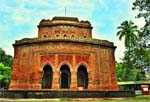 Architecture of any country reflects the picture of culture, past and present of that area. Architecture of Bangladesh refers to the architectural attributes and styles of the country.
Architecture of any country reflects the picture of culture, past and present of that area. Architecture of Bangladesh refers to the architectural attributes and styles of the country.
Basically architecture of Bangladesh refers to the architectural attributes and styles of the country. The architecture of Bangladesh has a long history and is rooted in Bangladesh’s culture, religion and history. It has evolved over centuries and assimilated influences from social, religious and exotic communities. It has evolved over centuries and assimilated influences from social, religious and exotic communities. The architecture of Bangladesh bears a remarkable impact on the lifestyle, tradition and cultural life of Bangladeshi people and it can provide fascinating insight into the history.
In modern context, Bangladeshi architecture has become more diversified comprising reflections of contemporary architectural attributes, aesthetic artistic and technologically advanced forms. Since the inception of Bangladesh, economical advancement has boosted the architecture from its traditional forms to contemporary context.
With the growing urbanisation and modernisation, the architectural form is turning into modernity covering a wide range of its heritage and tradition. If we look into the forms, styles and characters of architectures of Bangladesh we will find a wide variety of architecture.
From modern buildings with blunt lines and endless windows to archaic mounds of structured earth, the opportunities for architectural sightseeing are virtually endless.
Dhaka, capital of Bangladesh, carries the heritage of more than 400 years of her history. Looking back at its historical past helps to understand the different architectural phases it has experienced and also compliments some of the marked architectures of the country. The city gained eminence with the dawn of the Mughals in Bengal, but there are traces of architectural ruins which prove her existence prior the Mughals.
Dhaka still embraces the reminiscence of mosques, tombs, forts, caravanserais and bridges from the 1610 to 1717 Mughal periods. Under the initiative of the colonial administrators of the British rule the architectural scenario of Dhaka deformed again. It evoked new areas with new buildings and the city grew in importance as an administrative, educational and commercial centre. The beginning of the twentieth century marks for the bulk of colonial architectures still existing in Dhaka city.
Paharpur offers the real architectural picture of Bangladesh. One of the finest examples of Buddhist monastic architecture, the Buddhist Vihara, can be found here. Occupying some 900-feet, the monastery is the largest of its kind in the Indian subcontinent.
Mainamati is a place like Paharpur to see the ancient archaeological place. Another great sight is the Satgambuz mosque of Bagerhat. More Middle Age in design, the construction enjoys a number of massive arches and simplistic linear arrangements.
More recent architectural masterpieces include the National Parliament building, the national monument and the National Mosque .
Before the 1990’s, Dhaka high-rises were primarily concentrated in one area, Motijheel. Now the city is much more decentralised, with at least half a dozen or so important clusters of high-rise offices. Taller buildings in Dhaka are typically 20 to 30 stories, with several dozen in this height range and several dozen more under construction. There are of course many more in the 10 to 20th range. Tallest current is the 37th.
More significant than individual height are the numbers and density of these buildings. Not so long ago, private homes were not uncommon, but now-a-days, high cost of land and high population density (Dhaka is second only to Hong Kong) makes high-rise apartment living increasingly the middle class norm.
One feature, which makes architecture in this region unique in its own forms with special qualities. Whatever came to Bengal ultimately was absorbed in the culture giving a fresh and new dimension to the existing framework.
To rejuvenate and capture the spirit of Bengali nationalism, formal monumental and civic buildings like memorials, museums, libraries, hospitals, and institutions are now being designed and built in an increasing number in independent Bangladesh, although these are often devoid of good architectural qualities.
Among these ‘Jatiya Smriti Soudha’ (National Memorial) at Savar stands out and is of a quality with its skilful abstraction of theme blended with the landscape and its ideal scale, it is a work, which can compare with the best work done internationally.
-With The New Nation input




















